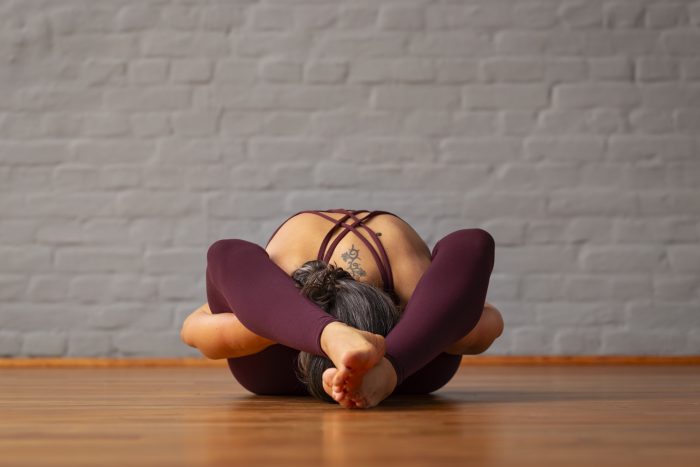Panic, grief, despair, and anger: today’s emotions in Prasārita Pādottānāsana C (wide legged forward bend) and in kūrmāsana (turtle).
My breath is short and shallow. I feel trapped, and I start to sweat.
Immediately, I want to get out of the posture, out of my body. Feeling deeply uncomfortable in my own skin.
A harmful past situation flashes in front of my inner eye. First an image, then suppression, followed by a familiar train of thought in my mind: it’s probably just imagination; it probably wasn’t as nearly as bad; you’re making this up.
After some dissection and awareness, I figured, this is not my voice but of other people who probably didn’t know better when I opened up to them.
However, the body knows, and those two yoga postures in my personal Ashtanga practice hold a key for me, which can unlock unknown potential and healing—but first discomfort.
I decided to confide in my yoga teacher and shared those inner workings with her. The answer was: feel into it, if you can.
Feeling into something that seems unbearable to hold? Don’t think so—so my first response. Despite my initial fear of turning this key, I decided to allow myself to pay attention to what was going on inside of me and replaced fear with curiosity. So, I made this conscious move into the unknown. I turned the key, and what I discovered there was vast loneliness.
So, I figured that what is said about trauma by Gabor Maté and other professionals seems to be true. It’s often not about what happened; it’s more about the lack of resources to hinder the experiences to rip into us as deeply.
And it’s the loneliness, feelings of separation from the collective well-being and the emotional isolation, which is to some people the most hurtful aspect. The event has happened; physically we don’t stay in that moment in time. But the moment can stay within us, stored in our nervous system, muscles, joints, and organs.
For those who are not aware or familiar with this part of yoga, I think it’s important to mention that such a process can take place in any yoga shape that touches stored experiences in your body. It doesn’t have to be specifically those postures from my experience.
These moments of discovery and processing may be terrifying and uplifting, all in one session. Moving through the motions and attached emotions can bring great relief and liberation after the discomfort that necessarily will be there first.
So after my embodiment of kūrmāsana, I am moving on to supta kūrmāsana, the sleeping turtle. The focus turns inward and beyond the first mental and physical resistance to ease into the pose. I notice that my breath begins to relax and is not rushed anymore by those challenging emotions from the pose before.
My ujjāyī breath, which translates to “the one who is victorious,” is my most important guide and point of reference here. A deep feeling of calm and peace floods my body, and I understand I have processed something on a cellular level. The analytical mind wants to know what and every detail of it, but the greater inner wisdom signals: that’s not necessary.
Moving through and holding those shapes in congruence with my inner world has enabled me to process what was restricting me emotionally, physically, and mentally. I understood that by repeating the sequence regularly, I am integrating the experience, which wasn’t available to me for a long time. It was of benefit to me that I was able to do this in a safe space in the presence of other people. I didn’t have to be on my own, in isolation, and I also didn’t have to speak about it at that moment.
This is a reminder that yoga derived from “to yoke,” which translates to unite. It’s the union of body, mind, and soul. It is so much more than a physical practice, a chant here and there, and wearing clothes from popular sport brands.
Living a life enriched by yoga can mean liberation, connection, trust, and community. That said, it can take some time to find, develop, and establish a yoga practice that suits your needs.
For me, it has been a journey of almost 20 years so far, and it’s still changing according to the seasons of my life. In those years, I got to know people from many different backgrounds walking this path of self-study (svādhyāya), and I will say I’ve learned something from all of them. Yes, we are all different, and yet in yoga, we have the opportunity of sharing so much of our differences and similarities, which can promote an inclusive collective, a togetherness.
Yoga can help you befriend your body, and by that I don’t mean changing it to make it conform more with mainstream ideas of ideal shapes. Rather, by extending love and paying respect to yourself when experiencing your body taking on these challenges and growing beyond them.
~
Please consider Boosting our authors’ articles in their first week to help them win Elephant’s Ecosystem so they can get paid and write more.












Read 2 comments and reply